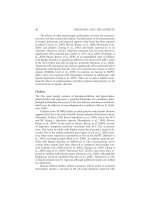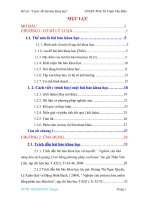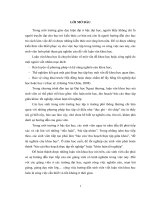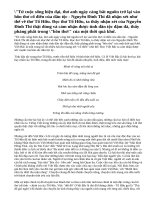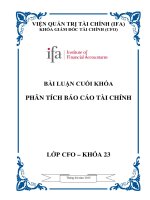Bài luận TESOL- Teaching Pre-School Children and Grade 1&2 English
Bạn đang xem bản rút gọn của tài liệu. Xem và tải ngay bản đầy đủ của tài liệu tại đây (118.31 KB, 15 trang )
Teaching Pre-School Children and
Grade 1&2 English
1.
ASSIGNMENT 1
Question 1: What are the four basic processes to understand how students
acquire language?
There are four basic processes to understand how students acquire language:
-
Socio-cultural
Language development
Academic development
Cognitive development
Question 2: What is Socio-cultural?
Socio-cultural: This process takes into consideration all parts of the student’s
life, both inside and outside of class. The student might feel anxiety or a sense
of displacement if they are segregated into a special ESL classroom, and
discrimination or prejudice might seriously affect the student ability to learn.
Question 3: What is Language development?
Language development: This process into consideration all aspects of the
student’s native tongue. The more the student is aware of his or her own
language, syntax, morphology, and pragmatics, the better aware they are of how
a second language functions. Without a firm grip of meta-language skills,
second language learning can be inhibited.
Question 4: What is Academic development?
Academic development: This process helps us understand that it is impossible
to separate language learning from concept learning. As each grade progresses
to the next level, language and vocabulary grows. By putting this process on
hold for Language Arts, Science, and Mathematics, or to segregate the students
into a strictly ESL classroom, the students start to form a gap between the
academic learning they have accomplished in their own language and the
learning they must complete in order to be successful in their new schools. This
gap can sometimes be insurmountable; leading to the student’s failing.
Question 5: What is Cognitive development?
Cognitive development: This process helps us understand that ESL
classrooms, by definition, water down and simplify education down to
uncomplicated sentences and tasks. This limits the student’s exposure to
challenging tasks, which then slows down the entire learning process. Regular
classes are not simplified, and students who are exposed to this simplicity have
problems once they are put into a regular classroom.
Question 6: Describe the typical three year old?
From the age of three, Pre-schoolers tend to be more peaceful, relaxed and
cooperative. Having just grown out of the “Terrible Two’s” the typical three
year olds are full of energy, eagerness and curiosity. Children of this age group
seem to be constantly moving about and excitedly engrossing themselves totally
in whatever captivates their interest.
This is a very rewarding age to teach as creativity is developing and imagination
is uninhibited. From this age vocabulary is rapidly expanding as the child is
now acquiring the foundation of its first language. Intellectual skills are visibly
developing as the child begins to express individual ideas, problem solve and
even plans ahead.
As their perception of the world around them expands children of this age group
also become more aware of the needs and feelings of others around them and
begin to exercise a degree of control of their own behavior. Although striving
for independence these children still need constant reassurance from caregivers
and parents that they are not alone and have an adult on hand to render
assistance when needed.
Question 7: How do 4 year olds try to contribute to the environment
around them?
By the age of four, children of this age group tend to be highly enthusiastic and
try hard to contribute to the environment around them by being “helpful”. Four
year olds are moving out into the world and can usually play happily with other
children and enjoy lots of physical games as well as stories. They are learning to
understand about the feelings and needs of others, and their behavior shows that
they can feel empathy for others and can share their toys and take turns, at least
some of the time. At this age, silly talk and silly jokes are frequent as well as
endless questions.
Question 8: Why are six year olds both enthusiastic and frustrated?
By the age of six, coordination has improved along with size and strength. New
challenges are met with a mixture of enthusiasm and frustration as they become
aware of limitations and choices. Development of cognitive functions means
that these children are able to see rules as useful for understanding everyday
events and the behavior of others. Six year olds typically are eager to learn,
lively and have a sense of humor these children are very often affectionate and
willing learners.
2.
ASSIGNMENT 2
Question 1: How do three and four year olds need to learn?
At the age of three young children learn best by active participation rather than
by simply watching. It is very important to join in with the children as they
play, actively taking part in their games while using very Basic English.
Four-year-old children still enjoy many of the same activities as the younger
three-year-old child but in addition to those activities, four year olds can also
benefit and learn from more structured activities.
Question 2: What shows the three year old has increased hand eye
coordination?
The ability to carry a container of liquid for instance a cup or bowl of water
without spilling much shows the increase of hand eye coordination as does the
ability to pour from one container to another something a child of three readily
enjoy. Building blocks are another medium children of this age can master and
typically can build a tower of blocks one atop the other.
Question 3: In what way do four year olds show they have increased motor
skills?
A four year old child’s motor skills have developed to the stage where they can
exercise much greater control over their physical body not only in what they can
do ie: run but also in how they choose to do it ie: run, starts, stops, runs faster
and runs around obstacles.
Hopping on one foot is another motor skill that a four year old can master and
will often play games where they hop around from foot to foot. When walking
the four year old can walk in a straight line following chalk or lines on the floor.
Climbing on ladders and up trees are highly enjoyable for this age as they
discover the world around them and they also can jump over objects from about
5-6 inches high.
Question 4: How does a four year old hold a crayon or marker pen? And
what does this show?
A four-year-old holds a crayon or marker pen with three fingers (tripod) style
drawing shows improvement and purpose.
Question 5: In what ways have hand eye coordination further developed in
six year old?
Hand eye coordination has increased the six year old dexterity enabling the
child to ride a bicycle unaided and participate in activities such as swinging a
bat and swimming.
Question 6: What language skill is starting to take shape at the age of six?
At this age, writing is beginning to take shape and can trace around objects, fold
and cut paper into basic shapes.
Question 7: By what age do children tend to be a little cautious in physical
activities?
By the age of seven children become more cautious and tend to be a little
hesitant when participating in challenging physical activities such as climbing
or jumping. At the age children tend to practice activities continuously until
they feel they have mastered them only to then become bored and more on to
another challenge.
Question 8: What activities do seven year olds benefit from?
Seven year olds benefit greatly from play acting activities and drama, role plays
and puppet shows are good ways to have them practicing language through
drama.
Have children practice short dialogue using gesturing and body language to
increase comprehension then have them act out the dialogue in a short skit or
play.
Dancing is another activity that this age group can enjoy play dancing games
like freeze to vocabulary or encourage children to dance to the door, window,
board and around the room chanting vocabulary as they go ie…“I’m dancing to
the door” and so on.
Question 9: Create a motor skill activity for 3-4 year olds for language
learning.
Have children sit in a circle, show them the numbers from 1-10 (by using
fingers) and throw a ball to each and in turn say “What is the number?”, when
the child grabs the ball answer the number they saw. Let the child throw the ball
back to teacher by saying “Give it back to me” with using gesturing, then
teacher throw a ball to another child, repeat until all the children have done this
activity.
Question 10: Create a motor skill activity for 7 year olds for language
learning.
Have the children make a pair, have them practice a short dialogue, for
example:
“Child 1: What animal is this?
Child 2: It’s a cat.
Child 1: Do you like cats?
Child 2: Yes, I do.
Child 1: Do you like pigs?
Child 2: No, I don’t.”
Give each pair some pictures of different animals, let them practice then act out
the dialogue in a short skit.
3.
ASSIGNMENT 3
Question 1: What shows that 3 year olds can cope with learning new
sounds? And produce them?
In their native language three year olds can begin to distinguish homophones
(words which sound similar) such as fish-dish in English. This distinction show
that the children are able to cope with learning complex new sounds and be able
to produce them.
Question 2: Approximately how many words in their native language can a
three year old speak?
A three year old can speak approximately 300 to 1000 vocabulary words in their
native language.
Question 3: What kinds of books are good for 3 year olds?
At the age of three children can enjoy storybooks written with simple one and
two syllable nouns and verbs with very basic vocabulary and large action
pictures. Three year olds will often comment during stories read in their native
tongue that relate to familiar topics such as family and animals. Picture books
are good for this age group.
Question 4: In what way can four year olds make comparisons?
Instead of understanding, only height or size four year olds now can make
comparisons such as “the biggest mountain” or “the smallest mouse”.
Question 5: By the age of four what are children able to express?
By the age of four, children are able to express their needs and how they want
these met.
Question 6: What skill is evident by age 5?
Classification skills are evident at this age and children typically sort objects by
classifying them. All the toy cars, all the food items, all the blocks sorting them
into different groups. Sorting can also be two dimensions as in color or form as
this age group has a good understanding of the concepts of shape and size.
Classification also extends to sorting objects from the smallest to the tallest
showing skill evidence of comparisons.
Question 7: What has vocabulary extended to by age 5?
Vocabulary for this age group has extended to at least 1500 words or more and
these children love to tell stories and hold a listening ear. In their native
language, five year olds can explain about people and things and relate
functions to objects such as you drive a car an fly an airplane.
Question 8: Why are six year olds more able to enjoy activities such as
puzzles?
The six-year-old child has now developed a much longer attention span and is
able to work at tasks for much longer periods of time. Because of the increased
attention span six year olds enjoy playing with puzzles and are able to work on
them until completion.
Question 9: Create a cognitive skill activity for 5-6 year olds for language
learning.
Have the children make a pair and sit back to back, then give each child a paper.
In this paper has a table with 9 numbers from 1-9 in any order. For example:
3
7
2
8
1
5
6
4
9
With each pair, the first child calls out any number in his paper, the second
child draws X in the number they hear, then the second child calls out another
number, the first traces the number they hear. Repeat until one of them has 2
lines of numbers first, the child has 2 line first will be the winner.
Question 10: Create a cognitive skill activity for 7 year olds for language
learning.
Have the children make a pair. Give word puzzles to each pair and explain them
how to find these given words. For example:
B A A K T P G N C Q P E M C G
Q
E
I
X
Q
F
M
A
W
F
N
J
F
G
I
R
Q
U
V
V
G
O
A
L
G
P
B
J
A
R
J
G
E
N
C
N
N
W
D
G
L
G
P
C
D
J
F
V
C
O
W
K
E
H
V
Z
I
B
B
A
R
Y
T
U
R
F
E
K
J
P
J
Y
O
O
B
N
J
K
K
Q
H
Y
J
S
N
E
H
Z
A
X
M
N
P
O
P
S
J
C
I
R
Y
H
D
Q
E
K
A
N
S
K
P
T
B
R
P
M
W
R
T
R
G
T
K
L
W
Q
T
E
A
O
T
E
W
O
G
G
O
F
X
Y
L
H
I
F
Z
D
O
U
K
E
I
R
A
X
I
T
J
U
F
S
O
K
P
F
T
P
Y
P
BIRD
COW
ELEPHANT
MONKEY
RABBIT
4.
A
D
D
A
A
E
U
C
M
L
N
P
X
Y
O
G
W
D
J
J
C
F
C
M
X
Z
M
K
P
E
J
H
Q
N
F
I
F
A
S
M
J
S
CAT
DOG
GIRAFFE
PIG
SNAKE
ASSIGNMENT 4
Question 1: What are 8 TESOL approaches? And which 2 are most useful
for the ESL classroom?
The 8 language learning approaches are:
1.
2.
3.
4.
5.
6.
7.
8.
Grammar Translation Approach
Natural Approach
Task-Based Approach
Lexical Approach
Learner-Based Approach
Whole Language Approach
Communicative Approach
Eclectic Approach (Combination of Approaches)
Whole Language Approach and Communicative Approach are most useful for
the ESL classroom.
Question 2: How many items or words should be taught for 3 and 4 year
olds in a lesson?
For ages 3 and 4, lesson plans should only teach 1 or 2 letters or numbers per
lesson, or 1 new vocabulary word.
Question 3: For 3 and 4 year olds how long should a topic or theme be
taught?
For 3 and 4 year olds, a topic or theme should be taught for the entire week with
plenty of games and opportunities for meaningful repetition.
Question 4: What is a “Bag of tricks”? And what is it used for?
A “Bag of tricks” means additional activities on hand in case the lesson finishes
early or a particular activity does not work as planned. It is used to help the
teacher do not loose control of the class and keep the interest of the students.
Question 5: How should lesson activities be chosen?
Every lesson should include certain features and follow a theme ie: alphabet,
animals, fruits or family members. Once the topic has been chosen all activities
should follow this theme.
Question 6: Create a 45 minute lesson plan for 3-4 year olds; make sure it
is age/skill/topic appropriate.
Topic: Colors
Level: Beginner
Age: 3-4 years
Length: 45 minutes
Language skills: Listening and Speaking
Lesson objectives: To recognize and pronounce 2 colors – red and blue.
TESOL methodology: Eclectic approach, flashcards, games
Materials: balloons, flashcards, balls, video.
Pre-task/ Warm up: 5 minutes
-Show a bunch of balloons with 2 colors red and blue.
-Ask children “Do you like balloons?”, encourage them to answer “Yes”.
-Ask each child come to pick up the balloons from teacher, bring to their place.
Teaching: 5-10 minutes
-Demonstrate word 5 times with flashcards. Encourage class to repeat choral
drill 5 times. Then ask individual students to repeat.
-Repeat with the next word.
-Class practice choral drill with the first and second word, then individual
student practice at random.
Task: 20-25 minutes
Task 1: Throw a ball
-Children form a circle.
-Teacher holds 2 balls in hands (one is red, one is blue), throws a ball with any
colors to any child.
-The child who has the ball call out color of the ball.
-Repeat until all children practice.
Task 2: Balls collecting
-Children form 2 teams, one is named “RED”, one is “BLUE”.
-Teacher puts many small balls (about 50-100 balls) with different colors
(green, yellow, pink, white, red, blue…) into a large basket.
-The RED team has to collect only red balls in the basket and the BLUE team
has to collect only blue balls. Which team has more balls within 2 minutes will
be the winner.
Task 3: Show a video
-Show a video of clothes, in which has many colors.
-Teacher calls out blue or red color when they appear encourage children to
follow and call out.
Task 4: Run to flashcards
- Children form 2 teams.
-Put flashcards on board.
-Teacher calls out color, in turn student of each team run to the right flashcard.
The faster has point. The team has more points is the winner.
Follow-up: 3-5 minutes
Children hold up and wave balloons when their color is called out. Encourage
children to call out the right color.
Homework: 2 minutes
Ask children to find toys has blue or red color at their home.
Question 7: Create a 45 minute lesson plan for 5-6 year olds; make sure it
is age/skill/topic appropriate.
Topic: Everyday action verbs
Level: Pre-beginner
Age: 5-6 years
Length: 45 minutes
Language skills: Listening and Speaking
Lesson objectives: To recognize and pronounce 3 actions: jumping, hoping and
running.
TESOL methodology: Eclectic approach, flashcards, games.
Materials: flashcards, teddy bears, video.
Pre-task/ Warm up: 5 minutes
-Show a video of the song “Five little monkeys jumping on the bed”
-Teacher sings and does actions using gestures.
-Encourage children sing and follow these actions.
Teaching: 10 minutes
-Demonstrate word 5 times with flashcards. Encourage class to repeat choral
drill 5 times. Then ask individual students to repeat.
-Repeat with the next word.
-Class practice choral drill with the first and second word, then individual
student practice at random.
Task: 25 minutes
Task 1: Run to flashcards
- Children form 2 teams.
-Put flashcards on board.
-Teacher calls out actions, in turn student of each team run to the right
flashcard. The faster has point. The team has more points is the winner.
Task 2:
-Children form 2 teams.
-Two first students of 2 teams come to teacher, teacher gives them a flashcard.
-Two children demonstrate the word by acting out. Others students guess the
word. The team gives answer first will have point.
Task 3:
-Give children teddy bears
-Demonstrate making teddy jumping, hoping or running while saying the word.
Task 4: Simon says
- Children form a circle.
-Teacher demonstrates game “Simon says” using words jumping, hoping,
running, crying, laughing…
-Children play “Simon says”.
Follow-up: 5 minutes
-Children form a circle.
-One child acts out, others children call out the words.
Question 8: Create a 45 minute lesson plan for 7 year olds; make sure it is
age/skill/topic appropriate.
Topic: Animals
Level: Beginner
Age: 7 years
Length: 45 minutes
Language skills: Listening and Speaking
Lesson objectives: To recognize and pronounce 5 animals: cat, dog, cow,
snake, duck.
TESOL methodology: Eclectic approach, flashcards, games, painting, puzzles.
Materials: flashcards, songs, masks, papers, paints, video, puzzles.
Pre-task/ Warm up: 5 minutes
-Show a video of the song “Old Mc Donal”
-Teacher sings and acts out like animals in the video.
-Encourage children sing and follow these actions.
Teaching: 10 minutes
-Demonstrate word 5 times with flashcards. Encourage class to repeat choral
drill 5 times. Then ask individual students to repeat.
-Repeat with the next word.
-Class practice choral drill with the first and second word, then individual
student practice at random.
Task: 25 minutes
Task 1: Match up
-Give each student a card. There are 2 types of cards, some cards have the
names of animals, others have the pictures of animals.
- Children go around room and find the friend who has the appropriate card. For
example: The child has card “Dog” has to find the friend who has the picture of
a dog in his card.
Task 2: Run to flashcards
-Children form 2 teams.
-Place flashcards around room, teacher calls out the name of animals, in turn
student of each team run to the right flashcard. The faster has point. The team
has more points is the winner.
Task 3: Paint animal masks
-Give children animal masks.
-Give them 5 minutes to paint their mask.
Task 4: Roll a play
-Children form a pair.
-Give children a short dialogue, ie:
“ Hi! My name is Cat!
Hi! I’m Dog.
Do you like Snake?
No, I don’t. And you?
Me too/ Yes, I do.”
-Each pair wear masks and practice the dialogue.
-After 5 minutes, each pair of animals act out in a short play.
Follow-up: 3-5 minutes
-Children form a circle.
-One child acts out an animal, others children call out the name of animal.
Homework: 2 minutes
Give word puzzles to each child and explain them how to find these given
words.
B
Q
E
I
X
Q
F
M
A
W
F
N
J
F
G
A
I
R
Q
U
V
V
G
O
A
L
G
P
B
J
A
A
R
J
G
E
N
C
N
N
W
D
G
L
G
K
P
C
D
J
F
V
C
O
W
K
E
H
V
Z
T
I
B
B
A
R
Y
T
U
R
F
E
K
J
P
BIRD
COW
ELEPHANT
MONKEY
RABBIT
P
J
Y
O
O
B
N
J
K
K
Q
H
Y
J
S
G
N
E
H
Z
A
X
M
N
P
O
P
S
J
C
N
I
R
Y
H
D
Q
E
K
A
N
S
K
P
T
C
B
R
P
M
W
R
T
R
G
T
K
L
W
Q
Q
T
E
A
O
T
E
W
O
G
G
O
F
X
Y
P
L
H
I
F
Z
D
O
U
K
E
I
R
A
X
E
I
T
J
U
F
S
O
K
P
F
T
P
Y
P
M
A
D
D
A
A
E
U
C
M
L
N
P
X
Y
C
O
G
W
D
J
J
C
F
C
M
X
Z
M
K
G
P
E
J
H
Q
N
F
I
F
A
S
M
J
S
CAT
DOG
GIRAFFE
PIG
SNAKE
Question 9: What are the 3 levels of classroom management?
1.
2.
3.
Low-level management: Make eye contact with a student who is
misbehaving or about to misbehave. Speaking slowly but deliberately ask the
student not to misbehave. Move around the classroom while you talk to
students and be involved in what they are doing.
Mid-level management: This involves management where a student is
singled out for misbehavior. If a student is misbehaving, walk to the child
and stand beside the student’s shoulder. This will usually curb any
misbehavior.
High-level management: This involves actually removing the student from
the activity by using hand-holding technique.
Question 10: What kind of learning environment should the pre-school
classroom be?
A “Safe” environment is learning environment the pre-school classroom should
be. Each country will have guidelines for what is required in the way of “safety
standards” reporting accidents/incidents and what classroom and playground
equipment can be used.
These guidelines or requirements should always be followed. When working in
a foreign Pre-school or Kindergarten it is important to check with the school for
local standards or requirements. Common sense is a good guide though and
always avoid activities or toys, which could cause a safety concern ie: choking,
injury or poisoning.

